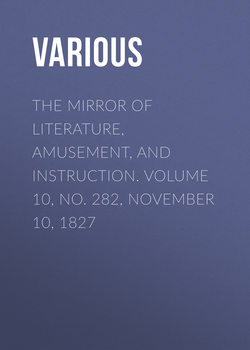The Mirror of Literature, Amusement, and Instruction. Volume 10, No. 282, November 10, 1827

Реклама. ООО «ЛитРес», ИНН: 7719571260.
Оглавление
Various. The Mirror of Literature, Amusement, and Instruction. Volume 10, No. 282, November 10, 1827
Architectural Illustrations
No. III. HANOVER TERRACE, REGENT'S PARK
THE ISLE OF SHEPPEY
ANTICIPATED FRENCH MILLENNIUM, OR THE PARISIAN "TRIVIA."
CARRYING THE TAR BARRELS AT BROUGH, WESTMORELAND
CUSTOM OF BAKING SOUR CAKES
SONG
THE ORIGIN OF PETER'S PENCE
ARCANA OF SCIENCE
Black and White Swans
Fascination of Snakes
Boring Marine Animals
Anthracite, or Stone Coal
Holly Hedges
Egg Plants
Vinegar made from Black Ants
Soil for Fruit Trees
Watch Alarum
THE MONTHS
NOVEMBER
SPIRIT OF THE PUBLIC JOURNALS
THE ROBBER SPATOLINO
AN UNINSURABLE RISK
LONDON NEWSPAPERS
MADEMOISELLE CUVIER
HOW TO LOSE TIME
SLEEPING AFTER DINNER
THE SELECTOR; AND LITERARY NOTICES OF NEW WORKS
CHRONICLES OF THE CANONGATE
A PERSIAN FABLE
THE GATHERER
NEW READING
O. P. RIOTS
A CURIOUS FACT
SIGNS OF THE TIMES
OLD GRIMALDI
NEGROES' HEIR LOOM
GRATITUDE
Отрывок из книги
"The architectural spirit which has arisen in London since the late peace, and ramified from thence to every city and town of the empire, will present an era in our domestic history." Such is the opinion of an intelligent writer in a recent number of Brande's "Quarterly Journal;" and he goes on to describe the new erections in the Regent's Park as the "dawning of a new and better taste, and in comparison with that which preceded it, a just subject of national exultation;" in illustration of which fact we have selected the subjoined view of Hanover Terrace, being the last group on the left of the York-gate entrance, and that next beyond Sussex-place, distinguishable by its cupola tops.
Hanover Terrace, unlike Cornwall and other terraces of the Regent's Park, is somewhat raised from the level of the road, and fronted by a shrubbery, through which is a carriage-drive. The general effect of the terrace is pleasing; and the pediments, supported on an arched rustic basement by fluted Doric columns, are full of richness and chaste design; the centre representing an emblematical group of the arts and sciences, the two ends being occupied with antique devices; and the three surmounted with figures of the Muses. The frieze is also light and simply elegant. The architect is Mr. Nash, to whose classic taste the Regent's Park is likewise indebted for other interesting architectural groups.
.....
"Regent's Park, and its circumjacent buildings, promise, in few years, to afford something like an equipoise to the boasted Palace-group of Paris. If the plan already acted upon is steadily pursued, it will present a union of rural and architectural beauty on a scale of greater magnificence than can be found in any other place. The variety is here in the detached groups, and not as formerly in the individual dwellings, by which all unity and grandeur of effect was, of course, annihilated. These groups, undoubtedly, will not always bear the eye of a severe critic, but altogether they exhibit, perhaps, as much beauty as can easily be introduced into a collection of dwelling-houses of moderate size. Great care has been, taken to give something of a classical air to every composition; and with this object, the deformity of door-cases has been in most cases excluded, and the entrances made from behind. The Doric and Ionic orders have been chiefly employed; but the Corinthian, and even the Tuscan, are occasionally introduced. One of these groups is finished with domes; but this is an attempt at magnificence which, on so small a scale, is not deserving of imitation."
Now, respecting the origin of this custom, I merely, by way of hint, submit, that in the time of Christian martyrdom, as tar barrels were used for the "burning at the stake" to increase the ravages of the flame:—the custom is derived,—out of rejoicings for the abolition of the horrid practice, and this they show by carrying them on their heads (as represented at page 296, vol. 8.), but you may treat this suggestion as you please, and perhaps have the kindness to substitute your own, or inquire into it.
.....